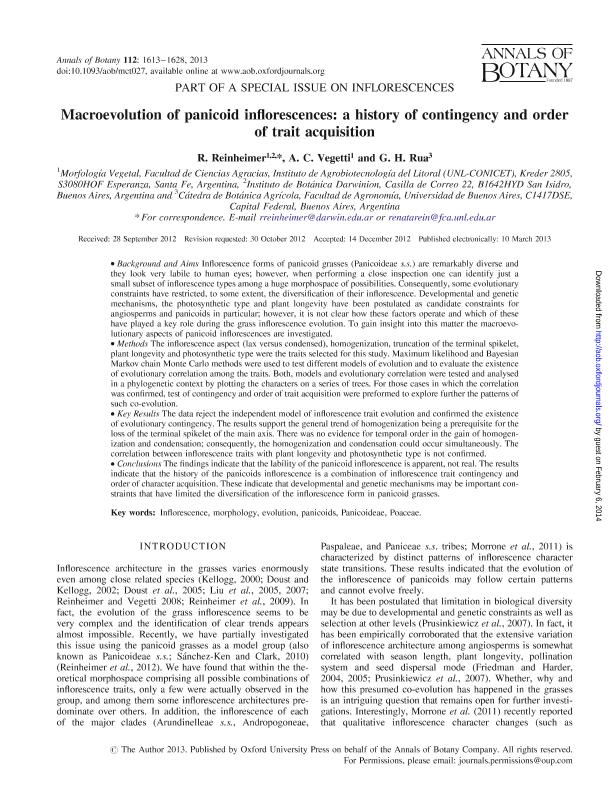Mostrar el registro sencillo del ítem
dc.contributor.author
Reinheimer, Renata

dc.contributor.author
Vegetti, Abelardo Carlos

dc.contributor.author
Rua, Gabriel Hugo

dc.date.available
2016-09-07T20:29:54Z
dc.date.issued
2013-12
dc.identifier.citation
Reinheimer, Renata; Vegetti, Abelardo Carlos; Rua, Gabriel Hugo; Macroevolution of panicoid inflorescences: a history of contingency and order of trait acquisition; Oxford University Press; Annals Of Botany; 112; 12-2013; 1613-1628
dc.identifier.issn
0305-7364
dc.identifier.uri
http://hdl.handle.net/11336/7552
dc.description.abstract
Background and Aims: Inflorescence forms of panicoid grasses (Panicoideae) are remarkably diverse and they look very labile to human eyes; however, when performing a close inspection one can identify just a small subset of inflorescence types among a huge morphospace of possibilities. Consequently, some evolutionary constraints have restricted, to some extent, the diversification of their inflorescence. Developmental and genetic mechanisms, the photosynthetic type and plant longevity have been postulated as candidate constraints for angiosperms and panicoids in particular; however, it is not clear how these factors operate and which of these have played a key role during the grass inflorescence evolution. To gain insight into this matter the macroevolutionary aspects of panicoid inflorescences are investigated. Methods: The inflorescence aspect (lax versus condensed), homogenization, truncation of the terminal spikelet, plant longevity and photosynthetic type were the traits selected for this study. Maximum likelihood and Bayesian Markov chain Monte Carlo methods were used to test different models of evolution and to evaluate the existence of evolutionary correlation among the traits. Both, models and evolutionary correlation were tested and analysed in a phylogenetic context by plotting the characters on a series of trees. For those cases in which the correlation was confirmed, test of contingency and order of trait acquisition were preformed to explore further the patterns of such co-evolution. Key Results: The data reject the independent model of inflorescence trait evolution and confirmed the existence of evolutionary contingency. The results support the general trend of homogenization being a prerequisite for the loss of the terminal spikelet of the main axis. There was no evidence for temporal order in the gain of homogenization and condensation; consequently, the homogenization and condensation could occur simultaneously. The correlation between inflorescence traits with plant longevity and photosynthetic type is not confirmed. Conclusions: The findings indicate that the lability of the panicoid inflorescence is apparent, not real. The results indicate that the history of the panicoids inflorescence is a combination of inflorescence trait contingency and order of character acquisition. These indicate that developmental and genetic mechanisms may be important constraints that have limited the diversification of the inflorescence form in panicoid grasses.
dc.format
application/pdf
dc.language.iso
eng
dc.publisher
Oxford University Press

dc.rights
info:eu-repo/semantics/openAccess
dc.rights.uri
https://creativecommons.org/licenses/by-nc-sa/2.5/ar/
dc.subject
Inflorescence
dc.subject
Morphology
dc.subject
Panicoids
dc.subject
Panicoideae
dc.subject
Poaceae
dc.subject.classification
Ciencias de las Plantas, Botánica

dc.subject.classification
Ciencias Biológicas

dc.subject.classification
CIENCIAS NATURALES Y EXACTAS

dc.title
Macroevolution of panicoid inflorescences: a history of contingency and order of trait acquisition
dc.type
info:eu-repo/semantics/article
dc.type
info:ar-repo/semantics/artículo
dc.type
info:eu-repo/semantics/publishedVersion
dc.date.updated
2016-01-12T13:08:16Z
dc.journal.volume
112
dc.journal.pagination
1613-1628
dc.journal.pais
Reino Unido

dc.journal.ciudad
Oxford
dc.description.fil
Fil: Reinheimer, Renata. Consejo Nacional de Investigaciones Científicas y Técnicas. Instituto de Botánica Darwinion; Argentina. Consejo Nacional de Investigaciones Científicas y Técnicas. Centro Científico Tecnológico Santa Fe. Instituto de Agrobiotecnologia del Litoral; Argentina
dc.description.fil
Fil: Vegetti, Abelardo Carlos. Consejo Nacional de Investigaciones Científicas y Técnicas. Centro Científico Tecnológico Santa Fe. Instituto de Agrobiotecnologia del Litoral; Argentina
dc.description.fil
Fil: Rua, Gabriel Hugo. Universidad de Buenos Aires; Argentina
dc.journal.title
Annals Of Botany

dc.relation.alternativeid
info:eu-repo/semantics/altIdentifier/url/http://aob.oxfordjournals.org/content/112/8/1613.abstract
dc.relation.alternativeid
info:eu-repo/semantics/altIdentifier/doi/http://dx.doi.org/10.1093/aob/mct027
Archivos asociados
